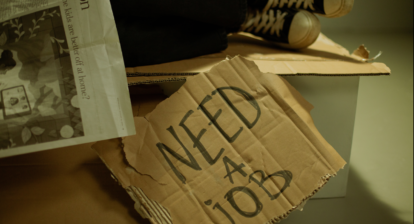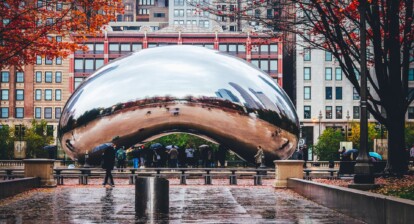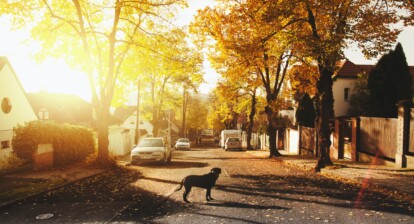Neighborhoods. While we all live in one, we rarely give neighborhoods the attention they should have. I know that I do take them for granted, belittle the possibility of change, and disregard my own potential influence. Perhaps the lack of attention paid to neighborhoods is due to us, as a society, not being fully aware of the enormous impact that neighborhoods can have on our lives. When considering factors in how to improve the well-being of our fellow citizens, we rightfully think of, for example, health and physical activity. However, we should keep in mind that the place someone lives in can directly influence these matters [1]. Thus, to improve the well-being of people, we also need to improve the quality of neighborhoods.
But how should this be done? And what factors should be taken into consideration? In this blogpost the thought process behind the development of a detailed policy intervention will be demonstrated and explained. In this way, we encourage you to think of your own neighborhood and to gather ideas of how it could be improved. Surely, after reading the post, you will come up with several great ideas yourself!

First, the neighborhood should be inspected. Go for a walk in the neighborhood and make observations. Think about what kind of people live there. How old are they? Do they live alone or with families? Also consider the quality of housing. Do people live in apartment buildings or stand-alone houses? And think about signs of disorder. Can you see trash, smell stench, hear noise? What about interactions? Do neighbors greet each other? In essence, the first step is to put yourself into the shoes of the residents of the neighborhood to have an idea of how it is to live there.
We decided to have a closer look at the situation of Stockhasselt South. A neighborhood in the North of Tilburg, Stockhasselt made it several times into the press, but rarely in a good light [2]. It is considered the problem neighborhood of Tilburg. However, a visit to Stockhasselt South opened our eyes. While Stockhasselt South and Stockhasselt North are rarely considered distinctive, as they together form one neighborhood, the two parts are very different. The northern part’s characteristics are apartment buildings, young families with seemingly little money and resources, and high levels of ethnic diversity. The southern part, in contrast, distinguishes itself by large houses with their own gardens, protected by high walls and fences. Residents tend to be well-off, and in the second half of life. However, we noticed that while Stockhasselt South seems to have everything a neighborhood needs, people tend to stay indoors and not engage with neighbors.
Surely, one could argue that there is nothing wrong with spending time indoors. Nevertheless, in essence that is also not the problem. When neighbors tend to stay inside, they have less contact with the outside world. Thus, the frequency of contact with neighbors is not as high as when children play outside, parents meet, supervise and interact with each other. However, numerous studies show the importance of a strong neighborhood network [3], which is often referred to as the concept of neighborliness for well-being. When neighbors know the names of each other and help out in times of need, residents have a stronger support system and less worries [4]. Thus, when residents stay increasingly indoors and lose contact with the outside world, their well-being and the well-being of the neighborhood can be impacted negatively.
Our example intervention idea addresses the outlined problem. It aims at increasing the frequency of contact among citizens of Stockhasselt and Tilburg and hence improving neighborliness and also social cohesion within communities. Nevertheless, maybe the neighborhood you looked into has other qualities and weaknesses that you want to address with your idea for change. Maybe you observe a strong neighborhood organization but also notice that it is difficult for new residents to get welcomed in the network. Or you think that due to the housing situation which does not provide green space, residents would benefit from a shared community garden. In essence, consider the neighborhood, and then try to collect as many ideas as you can.
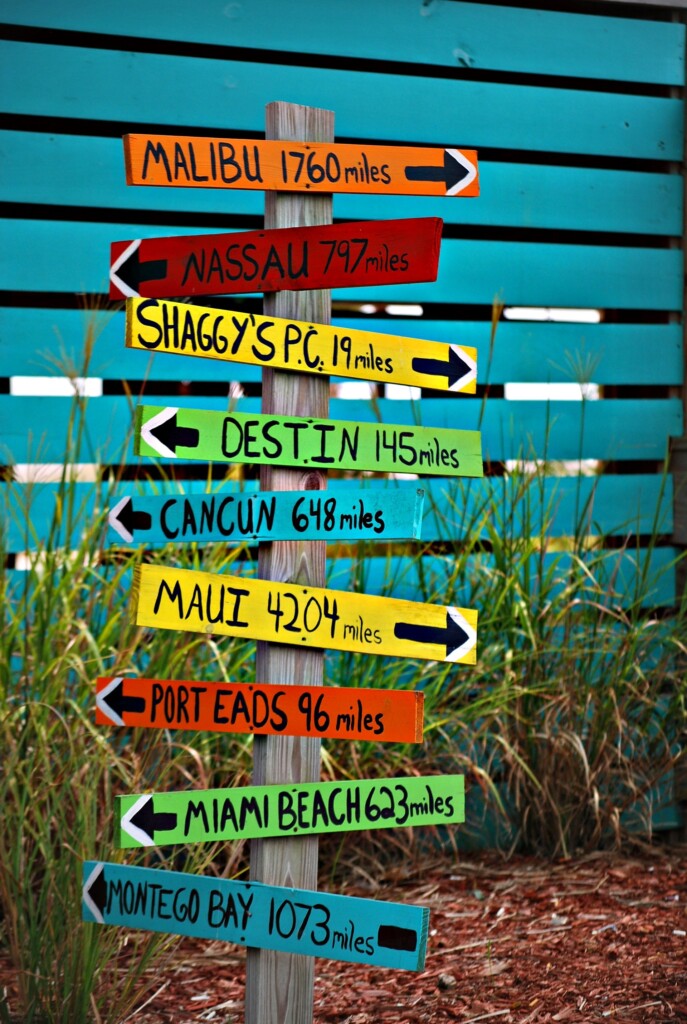
However, keep in mind: there is no ultimate solution! Difficulties in neighborhoods tend to be wicked problems, that is problems that are not solvable as they are complex in nature and involve parties with contrasting interests[5]. There is never one fit-all solution. But to create one large scale idea should also not be the aim of your idea. Instead, try to focus and stay in a realm of what is realistic, easy to implement but improves the well-being of residents.
The idea that we came up with is the following. We want to put up several signs in Stockhasselt where it is clear that it is a meeting point for running groups. On the sign will be specific times at which groups will run past, and also the specific distance and running level will be mentioned. These meeting points are then connected via a specific running route. Also, a QR code will help runners easily understand the concept, to find an appropriate group in terms of ability and scheduling and hopefully motivate people of all ages from all around Tilburg and Stockhasselt to exercise regularly, and meet new people. In this way, we encourage people of Stockhasselt South and other parts of town to leave their houses, meet people and do sports.
A major challenge is how to motivate people to exercise when all they want is to stay on the couch. Of course, it will be impossible to design running groups and meeting points that are appealing to everyone. A diverse offer of group levels, distances, tempo, ages, and times will help to lower obstacles but in the end, of course it remains the choice of everyone themselves to join or not to join. Nevertheless, as explained above no single idea will make the change. Hence, as you can see, also our idea is nothing that will change the world. But that is also not what should be expected (and in personal opinion also not the responsibility of the civil society). Instead, we argue that we need more people proposing locally viable ideas. A neighborhood which, can improve itself little by little will be a place of endless possibilities.
As the American author and wife of Martin Luther King, Coretta Scott King so aptly put it:
“The greatness of a community is most accurately measured by the compassionate actions of its members.”
~ Coretta Scott King [6]
And one last reason why you should start to improve your neighborhood today: there is a strong body of literature showing that active engagement with the community has positive effects on your own mental health [7]. So in conclusion, by helping and engaging with the community, you also help yourself!
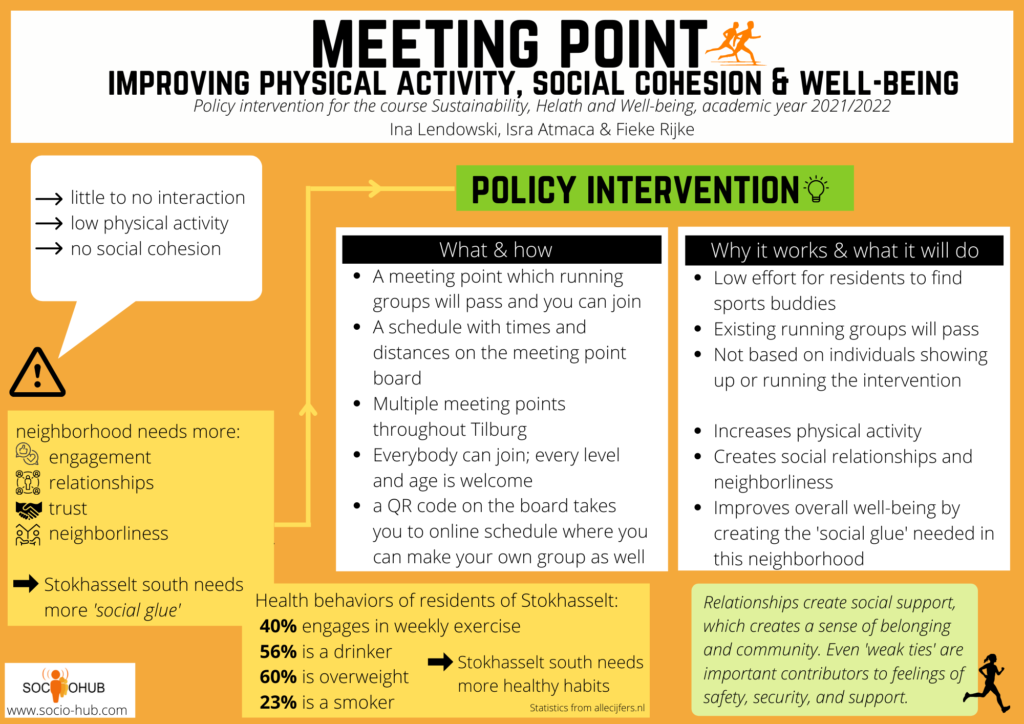
Referenties
[1] Vivier, P. M., Hauptman, M., Weitzen, S.H. et al. (2011) The Important Health Impact of Where a Child Lives: Neighborhood Characteristics and the Burden of Lead Poisoning. Maternal Child Health Journal 15, 1195–1202. https://doi.org/10.1007/s10995-010-0692-6
[2] Clevers, R. H. E. (2021, 29 mei). Dit is Stokhasselt, wijk die Tilburg al jaren zorgen geeft: ‘Je kunt hier niet de straat over zonder dat er iets naar je wordt geroepen’. bd.nl. Geraadpleegd op 8 april 2022, van https://www.bd.nl/tilburg-e-o/dit-is-stokhasselt-wijk-die tilburg-al-jaren-zorgen-geeft-je-kunt-hier-niet-de-straat-over-zonder-dat-er-iets-naar-je wordt-geroepen~ab94f560/
[3] Kim, J. (2009). Neighborhood disadvantage and mental health: The role of neighborhood disorder and social relationship. Social Science Research, 39(2), 260–271.
[4] Brown, S. C., Mason, C. A., Spokane, A. R., Cruza-Guet, M. C., Lopez, B., & Szapocznik, J. (2009). The Relationship of Neighborhood Climate to Perceived Social Support and Mental Health in Older Hispanic Immigrants in Miami, Florida. Journal of Aging and Health, 21(3), 431–459. https://doi.org/10.1177/0898264308328976
[5] Head, B. W. (2008). Wicked Problems in Public Policy. Public Policy, 3(2), 101-118.
[6] From Associated Press. (2019). King’s Widow Urges Acts of Compassion. Los Angeles Times. Retrieved April 2022 from https://www.latimes.com/archives/la-xpm-2000-jan-17- mn-54832-story.html#:%7E:text=%E2%80%9CThe%20greatness%20of%20a%20community,a%20soul %20generated%20by%20love.%E2%80%9D
[7] Fancourt, D., Bhui, K., Chatterjee, H., Crawford, P., Crossick, G., DeNora, T., & South, J. (2021). Social, cultural and community engagement and mental health: Cross-disciplinary, co-produced research agenda. BJPsych Open, 7(1), 1-6.


